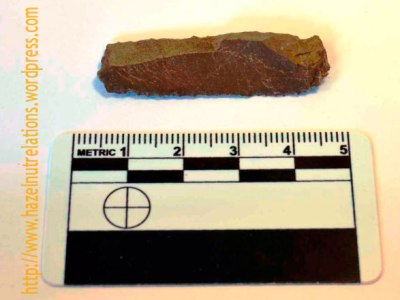In Switzerland the Neolithic first becomes really visible around 4300 BC, in fact it bursts onto the scene quite extravagantly: Palafittes, Seeufersiedlungen, lake side villages! Because of the fantastic preservation of organic finds such as wood and bone, they are the showstoppers of Swiss archaeology.

Sickle from Egolzwil, canton Lucerne, Switzerland; ca. 4300 BC. Wood and flint. Adapted from: Bachman & Hügi, 2004, Die Pfahlbauer/Les Lacustres: 150 Objekte erzählen 150 Geschichten / 150 objets racontent 150 histoires, p. 117
I have been wondering about sickles lately. About sickles of the earliest Neolithic and perhaps the latest Mesolithic and about the way they were used and what they might have been used to harvest. As finds of any kind dating to the earliest Neolithic up to about 4500 BC are very very rare in what is now Switzerland, it makes sense to use the fantastic archaeological archive of the Lake side villages. (Sickles also play quite a role in the history of use wear analysis and more here.)
4500 BC. That is when the Late Neolithic starts here. Before that there are a barely visible Early (from ca. 5500 BC) and Middle Neolithic (from ca. 5000 BC). We known of a few sites dating to the Early Neolithic, though. Some very rare
LBK settlements are found, mostly in those few scraps of Swissness north of the Rhine, such as two sites in Gächlingen, Schaffhausen and Bottmingen/Bäumliackerstrasse, Basel. A small remnant of an early deposit at the site of Herznach-Unterdorf, in the Aargauer Jura might be the first place where LBK pottery was found south of the Rhine (JbAS 2013, p. 172). Further “Neolithic” finds are know from unstratified contexts or from sites otherwise attributed to the Late Mesolithic. This includes La Hoguette pottery fragments and/or Bavans projectile points from, for example Baulmes/Abri de la Cure and Mont la Ville/Col du Mollendruz, Abri Freymond or sites in the canton of Lucerne. And indeed from Lutter/St. Joseph (FR), one of the two sites from which I am studying finds for my PhD, Grossgartach pottery is known. Lastly, occasionally occupation layers older than the Late Neolithic lake side villages are observed underneath Late Neolithic deposits, but the evidence is scant and there is not much more to say about these or the sickles that might once have been used by the people living in Bottmingen or in Baumles or Lutter. In the Alsace, North of my study sites, relatively many Early Neolithic sites are known.

Sickle from Burgäschisee, canton Berne, Switzerland; ca. 3500 BC. The extention at the top of the photo will have had a similar function as the hook on the sickle shown below.
Figure adapted from: Osterwalder & André, 1980. Fundort Schweiz Band 1.
Together with the archaeobotanical discussion about cereal-type pollen from off-site locations, the small Early Neolithic archaeological record leaves many questions unanswered. Questions about the definition of the “Neolithic” and “Mesolithic”, about the economies of the 7th and 6th millennium BC, about harvesting technologies and their first appearances in the archaeological record of the region. Naturally, this will all feature in my PhD research, in fact I have already conducted harvesting experiments (and here). But what do these sickles look like? Their striking variation is shown by the examples shown here. They are some of the older, well preserved sickles from Swiss (Late) Neolithic lake side villages. So, yes, sickles.

Sickle from Egolzwil, canton Lucerne, Switzerland; ca. 38000 BC. Ash wood, birch tar and flint. The hook at the end of the sickle (right) supposedly was used to collect a bunch of stems which can be grabbed with the free hand and then be cut with the sickle blade.
Figure adapted from: Bachman & Hügi, 2004, Die Pfahlbauer/Les Lacustres: 150 Objekte erzählen 150 Geschichten / 150 objets racontent 150 histoires, p. 125
P.S. I thought I would not bother you with references to scientific literature this time. Many can be found on hazelnut_relations. But do get in touch if you have questions.
















